Template:Infobox Coat of arms The Prince of Wales's feathers is the heraldic badge of the Prince of Wales. It consists of three white ostrich feathers emerging from a gold coronet. A ribbon below the coronet bears the motto Ich dien (German: [ɪç ˈdiːn], "I serve"). As well as being used in royal heraldry, the badge is sometimes used to symbolise Wales, particularly in Welsh rugby union and Welsh regiments of the British Army.
- coronet
- ostrich
- wales
1. Origins of the Badge
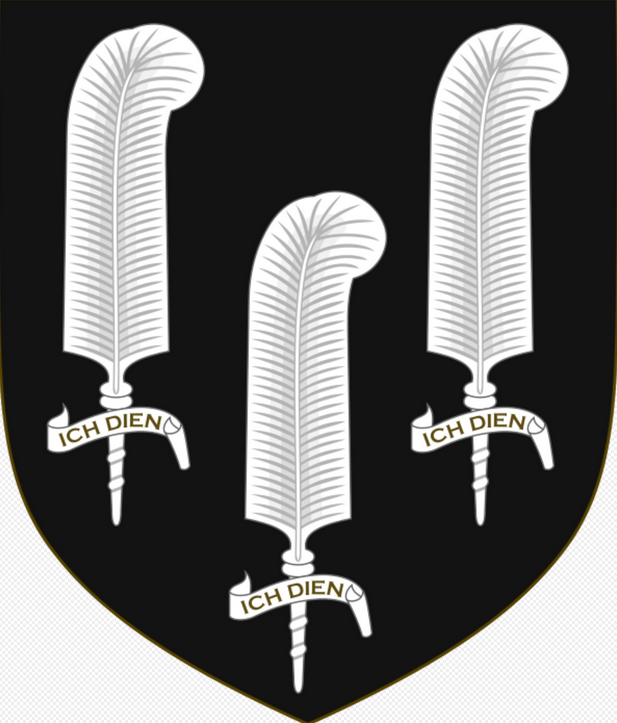
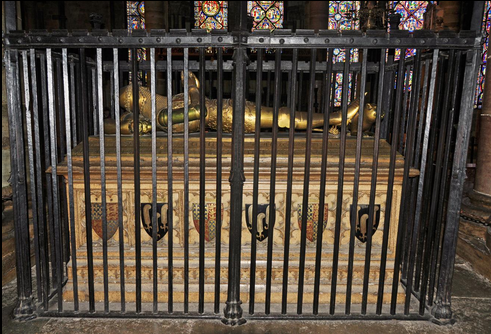
The badge has no connection with the native Princes of Wales.
Its use is generally traced back to Edward, the Black Prince (1330–1376), eldest son and heir apparent of Edward III of England. Edward bore (as an alternative to his differenced royal arms) a shield of Sable, three ostrich feathers argent, described as his "shield for peace", probably meaning the shield he used for jousting. These arms can be seen several times on his chest tomb in Canterbury Cathedral, alternating with his royal arms[1] (the royal arms of King Edward III differenced by a label of three points argent). The prince also used badges of one or more ostrich feathers in a number of other contexts.[2]
The feathers had first appeared at the marriage of Edward III to Philippa of Hainault, and it is therefore likely that the Black Prince inherited the badge from his mother.[3] Philippa was descended from the Counts of Hainault, whose eldest son bore the title "Count of Ostrevent", the ostrich (French: autruche, Old French spellings including ostruce) feathers being (perhaps) a heraldic pun on that name.[4][5][6] Alternatively, the badge may have derived from the Counts of Luxembourg, from whom Philippa was also descended, and who had used the badge of an ostrich.[4]
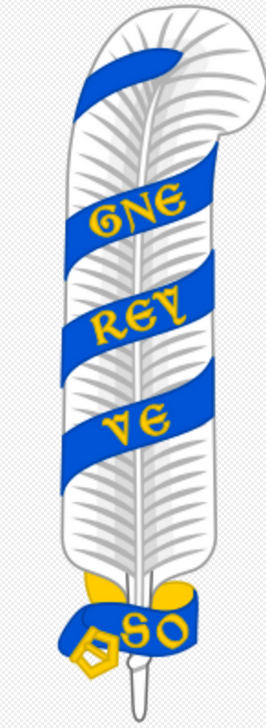
Edward III occasionally used ostrich feather badges,[5] as did other members of the royal family in the 14th and 15th centuries. The Black Prince's younger brother, John of Gaunt, used ostrich feathers in several contexts, including on a shield very similar to Edward's "shield for peace", although in Gaunt's case the feathers were ermine.[7][8] Edward's illegitimate son, Sir Roger de Clarendon, bore arms of Or, on a black bend, three ostrich feathers argent;[9] and his legitimate son, King Richard II, used ostrich feather badges in several colours.[10] Henry IV used a badge of a single ostrich feather with a scroll entwined around it bearing the motto "Ma sovereyne" or "Sovereygne"; and, of Henry's sons, Henry V used ostrich feathers as a secondary royal badge at various times, Thomas, Duke of Clarence used an ermine ostrich feather labelled; John, Duke of Bedford an ostrich feather with the "Sovereygne" scroll; and Humphrey, Duke of Gloucester an ostrich feather studded with fleurs-de-lis. Similar badges were used by other royal princes.[11][12]

The first Prince of Wales to use the badge in its modern form (i.e. three white feathers encircled by a coronet, and with the motto Ich dien) was Prince Arthur (1486–1502), eldest son of Henry VII, at the beginning of the 16th century.[4][13] It was also widely used by Prince Edward, son of Henry VIII and afterwards Edward VI, although he was never formally invested as Prince of Wales.[14] Feathers continued to be used as lesser royal badges, by Elizabeth I among others, until the end of the century.[15] Only from the beginning of the 17th century did the badge become exclusively associated with the Prince of Wales. It has been a part of the coat of arms of the Prince of Wales since at least 1901.
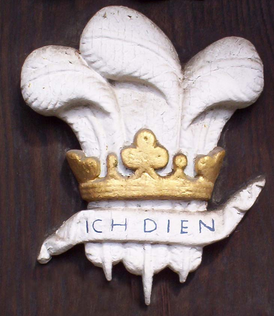
2. Popular Accounts of Origins
According to a longstanding legend, the Black Prince obtained the badge from the blind King John of Bohemia, against whom he fought at the Battle of Crécy in 1346. After the battle, the prince is said to have gone to the body of the dead king, and taken his helmet with its ostrich feather crest, afterwards incorporating the feathers into his arms, and adopting King John's motto, "Ich dien", as his own. The story first appears in writing in 1376, the year of the Black Prince's death. There is, however, no sound historical basis for it, and no evidence for King John having used either the crest (he actually bore a crest of vultures' wings) or the motto.[3][4][5]
Since a key factor in the English army's victory at Crécy was the use of Welsh archers, it is also sometimes said to have been Edward's pride in the men of Wales which led him to adopt a symbol alluding to their assistance. The mediaeval German motto "Ich dien" ("I serve") is a near-homophone for the Welsh phrase "Eich Dyn" meaning "Your Man", which might have helped endear the young Black Prince to the Welsh soldiers in particular. Again, however, there is no historical evidence to support this theory. In 1917, during the First World War, it was rumoured that the motto might be formally changed to "Eich Dyn" to avoid the use of German.[16]
3. Modern Uses of the Badge
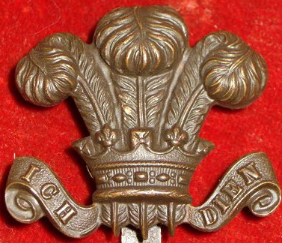
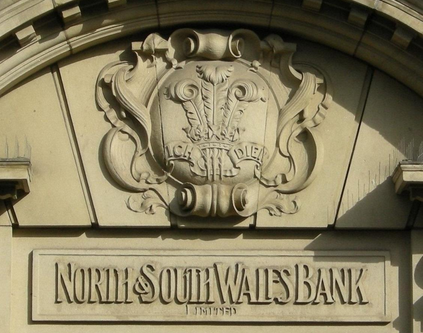
3.1. Military Uses
The plaque of HMS Norfolk has Ich dien beneath a single, crowned, feather. The badge is the cap badge of the Royal Welsh, an amalgamation of three Welsh regiments, the Royal Welch Fusiliers, the Royal Regiment of Wales and the Territorial Army's Royal Welsh Regiment. Previously it was the cap badge of the Prince of Wales' Own Civil Service Rifles, whose motto was also Ich dien.
The badge also appears as an element on the regimental badges of many other regiments of Commonwealth armies which have a historical connection with the Prince of Wales:
- The Royal Scots Dragoon Guards (Carabiniers and Greys) (as arm badge)
- Royal Marines Band Service Commando Training Centre Lympstone (part of cap badge)
- 9th/12th Royal Lancers (Prince of Wales')
- The Princess of Wales' Royal Regiment (Queen's and Royal Hampshires) (part of cap badge)
- The Staffordshire Regiment (The Prince of Wales') (part of cap badge)
- 2nd King Edward VII's Own Gurkha Rifles (The Sirmoor Rifles)
- The Royal Wiltshire Yeomanry (Prince of Wales' Own) (part of cap badge)
- The Cheshire Yeomanry (Earl of Chester's)
- 2 Squadron Honourable Artillery Company (squadron badge)
- 4th Battalion 8 Punjab Regiment
- 4th/19th Prince of Wales' Light Horse Regiment
- The Royal Regiment of Canada (part of cap badge)
- Ceylon Light Infantry
- Bengal Engineer Group
- The Princess of Wales' Own Regiment (part of cap badge)
- The Royal Monmouthshire Royal Engineers (part of cap badge)
- 2 Engineers (Pak Army) From 1805 Princess of Wales' Own
- The Royal Hussars (PWO) From 1969 to 1992[17]
- Prince of Wales Royal Indian Military College since 1922 currently known as Rashtriya Indian Military College
- HMS Prince of Wales
- One South African Infantry Battalion
3.2. Sporting Uses
The feathers have traditionally been worn on the jerseys of players in the Welsh rugby union team, being sewn on jerseys of players representing Welsh clubs before a national team or union existed. It has since been adopted as the logo of the Welsh Rugby Union (WRU). In the 1990s, the WRU modified the form of the badge they used to copyright the design. The new logo is more stylised, with "WRU" in place of "Ich dien". As the logo of the WRU, the Prince of Wales' feathers are also represented in one of the quarters of the British and Irish Lions' badge.
The Welsh Rugby League has stuck to the traditional three feathers with "Cymru RL" ("RL" standing for "rugby league") written underneath.
Surrey County Cricket Club were granted permission in 1915 to use the feathers for their badge. Their home ground, The Oval, is on land owned by the Prince of Wales.[18]
The feathers appear on the badge of Wrexham Association Football Club.

The feathers are used as the logo of Oxford University Rifle Club (OURC).[19]
3.3. Other Uses
The Carlton Club uses the feathered coronet badge as its emblem, without the motto.
Prince of Wales' College, Moratuwa, Sri Lanka, has used the feathers since the inception of the school in 1876.
The badge appeared on the reverse of the British two pence coins minted between 1971 and 2008, many of which remain in circulation. The badge appears as a provenance mark on those silver coins minted using Welsh mined silver in the seventeenth and eighteenth centuries.
During the English Civil War, most coins minted by Charles I at his various provincial wartime mints carry the feathers. The feathers appear on these coins because Charles I had no access to the Royal Mint in London and instead transferred the Aberystwyth Mint (originally established to coin Welsh silver) to Shrewsbury and then Oxford as an emergency measure. All the Civil War provincial mints are therefore in effect sub-branches of the Aberystwyth mint.
The badge was until 1985 on the coat of arms of Penang, a state in present-day Malaysia, which was founded in 1786 as the settlement of Prince of Wales Island.
The badge is inscribed on the foundation stone, laid on 25 February 1927, of Patna Medical College and Hospital, in Patna, Bihar, India, established in 1925 as the Prince of Wales Medical College. The motto "Ich dien" is still widely used within the institution.
The badge is used by a society in Malta called 'The Prince of Wales Philharmonic Society'. The scope of this organisation is mainly one related to music but is also linked to the feast of St. Dominic in Vittoriosa in Malta. Malta was a colony of the British Crown for 200 years, and there exist a variety of clubs and organisations bearing the name of royal personalities.
From 1932 until its abolition in 1965, the Municipal Borough of Barnes in London used feathers based on those of the Prince of Wales on its coat of arms, in honour of the fact that the then Prince of Wales (afterwards Edward VIII, and later Duke of Windsor) had been born in the borough.[20]
Norfolk County Council was given special consent by King Edward VII to use the badge on its arms, in recognition of Sandringham House, which was one of the King's favourite residences.[21] Edward held the title Prince of Wales for 59 years, making him the longest-serving holder.
A derivative of the badge is that used by the Prince's Trust, a charitable organisation that helps young people.
Many pubs in the UK are named The Prince of Wales's Feathers, the Prince's Feathers or simply the Feathers, particularly in areas associated with royal estates.
References
- Scott Giles 1929, pp. 89–91.
- Siddons 2009, pp. 178–9.
- nullScott-Giles 1929, p. 89.
- nullPinches and Pinches 1974, p. 59.
- nullSiddons 2009, p. 178.
- "6th letter". telegraph.co.uk (London). 30 August 2006. https://www.telegraph.co.uk/comment/letters/3631799/Letters-to-The-Daily-Telegraph.html.
- Siddons 2009, p. 181.
- Harris, Oliver D. (2010). ""Une tresriche sepulture": the tomb and chantry of John of Gaunt and Blanche of Lancaster in Old St Paul's Cathedral, London". Church Monuments 25: 7–35 (22–3).
- Scott-Giles 1929, pp. 90–91.
- Siddons 2009, pp. 179–80.
- Siddons 2009, pp. 182–6.
- Pinches and Pinches 1974, pp. 89–93.
- Siddons 2009, pp. 186–8.
- Siddons 2009, pp. 188–9.
- Siddons 2009, pp. 187–9.
- "Motto of Prince of Wales". Aberdeen Weekly Journal: p. 3. 14 September 1917. http://www.britishnewspaperarchive.co.uk/viewer/bl/0000573/19170914/089/0003.
- "The Royal Hussars (Prince of Wales Own)". Archived from the original on 19 October 2012. https://web.archive.org/web/20121019174316/http://hussars.org/wp/?page_id=187. Retrieved 2015-09-27.
- Williamson, Martin. "A brief history of Surrey". ESPNcricinfo. http://content-www.cricinfo.com/surrey/content/current/story/261883.html. Retrieved 16 July 2015.
- Oxford University Rifle Club http://www.ourc.org.uk/
- "Municipal Borough of Barnes". Heraldry of the World. http://www.ngw.nl/heraldrywiki/index.php?title=Barnes. Retrieved 11 November 2014.
- "Norfolk County Council". Civic Heraldry of England and Wales. http://www.civicheraldry.co.uk/east_anglia_essex.html#norfolk%20cc. Retrieved 9 December 2014.
